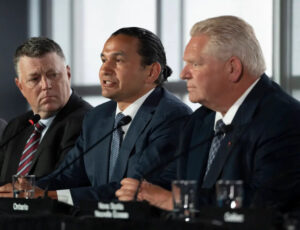
By Lester Bronzon Catarbas
Canada’s economic landscape is uniquely characterized by its vast geography and decentralized political structure, leading to a complex web of interprovincial trade barriers. These barriers, rooted in historical developments, continue to impede the free flow of goods, services and labor across provincial lines.
With the recent on and off threats from the Trump administration to impose damaging tariffs, is removing these barriers the solution?
What are interprovincial barriers
Interprovincial trade barriers primarily consist of regulatory discrepancies that complicate business operations across provinces. These include differences in professional credentialing, health and safety regulations and product classifications.
“The rules of the game vary from one place to the next, and that just makes it hard to buy and sell across border,” said Trevor Tombe, an economics professor at the University of Calgary in a report from The Canadian Press. “Navigating those different rules adds cost, therefore detracts from internal trade,” he added.

For instance, a commercial vehicle maybe required to undergo multiple inspections when crossing provincial borders due to varying safety standards. Similarly agriculture products might need federal inspection upon crossing into another province, even if they have already been inspected at a provincial level when it was produced. One popular example as well is the barrier to individual import of wine, beer and spirits. Most provinces have their own liquor retailers (LCBO for Ontario, BC’s BCLIQUOR, and AGLC for Alberta) and these retailers have different rules and regulations in selling, storing and labelling alcohol.
Tombe highlights that these barriers are largely the product of political inertia. Provinces naturally develop their own rules and regulations, and harmonizing these with neighboring jurisdictions is a complex task that often takes a backseat to more immediate priorities like healthcare and education.
The Canadian Chamber of Commerce (CCC) in its report have identified these barriers as “one of the country’s top 10 barriers to growth” and “a central impediment to Canada’s regulatory competitiveness”.

The economic Impact of its removal
Tombe, on his 2022 report he co-wrote for the Macdonald-Laurier Institute, estimated that eliminating interprovincial barriers could boost Canada’s gross domestic product (GDP) by between 4.4 and 7.9 per cent over the long term. In addition, he also estimated that opening up interprovincial trade could increase the size of the national economy by $200 Billion and that amount could reach up to $245 Billion today, which means thousands of dollars per person.
According to the Canadian Federation of Independent Business in its 2024 report, removing these barriers could boost economic growth by as much as $200 Billion per year or $5,100 per person. For them, removing these will allow businesses and consumers to benefit in several ways:
- Increased choices in goods and services
- Improved security of supply
- Greater affordability
- Bigger job market and efficient labour allocation
How is our government reacting to this
It is noted that in 2017, Ottawa has brought the provinces together to sign the Canadian Free Trade Agreement, which led to some provincial and federal rules being softened.
Recently, Prime Minister Justin Trudeau held an economic summit addressing interprovincial trade barriers. Trudeau said that premiers are united in reducing these barriers and that it is about time that we have genuine free trade in the country. “It’s gonna require all of us, not just governments but business leaders as well, to step up and push hard and make sure that in this moment we actually move forward on free trade within Canada,” he said.
Minister of Transport and Internal Trade Anita Anand said that these barriers are possible to be eliminated within a month.
“We are making incredible, fast-paced progress with all of the provinces and territories.”

In a press conference last month, Ontario Premier Doug Ford, Prince Edward Island Premier Dennis King and Manitoba Premier Wab Kinew engaged in discussions to harmonize regulations and facilitate smoother interprovincial commerce.
Conservative Leader Pierre Poilievre said he would remove as many trade barrier clauses as possible once elected prime minister. “Our new top trading partner will be… Canada,” he said in a video he posted on social media, outlining his plans to heavily increase internal trading within Canada.
For Tombe, scraping these barriers will definitely help with the country’s economic growth, but even with a quick action, real effects might take years to show up.
“There’s no avoding a recession, if indeed the U.S follows through with permanent 25 per cent tariffs on Canada, he said. “But overtime, we could potentially more than compesate.”

Be the first to comment